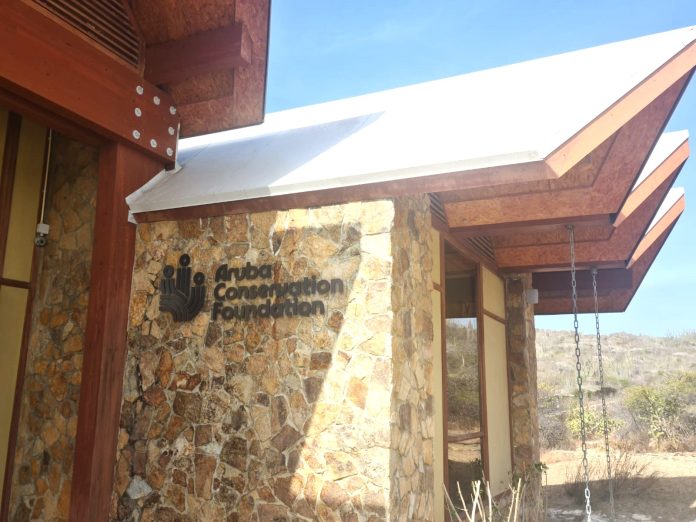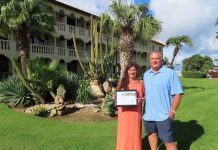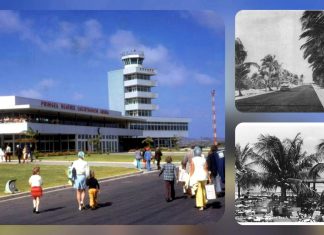Yesterday, the independent nature conservation organization known as Fundacion Parke Nacional Aruba (FPNA) took the opportunity of Earth Day to reveal its transformation, now becoming the Aruba Conservation Foundation (ACF).
In an interview with Edeline Berg, who serves as the communications & marketing manager, Tyson Lopez, CEO of the foundation, and Natasha Silva, who is the conservation director, they revealed that since June of last year, they have been discussing the organization’s transition from being a park management organization to a conservation organization.
Over the past 7 years, the foundation has expanded its role and responsibilities beyond managing Arikok National Park, being appointed to manage several additional protected areas around Aruba.
In 2017, they began to undertake more conservation actions, where sometimes the community didn’t fully understand what they were doing, such as closing an illegal entrance to the park at Shete, an unauthorized entry in the park’s design. “That was to try to minimize pathways to have fewer cars running with less impact on nature,” Lopez explained.
This year, the mangrove and saline RAMSAR site #198 Spaans Lagoon was added to the foundation’s responsibilities, and in 2019, the Marine Park, consisting of four protected marine areas, was officially placed under the organization’s management.
In 2020, 11 additional terrestrial areas were added to the management, including areas like Duinen Sasarawichi, Saliña Malmok, Rooi Lamunchi, and Costa Sero Colorado, among others.
Additionally, the foundation actively participates in conservation efforts, including collaboration with various local and international NGOs for programs such as conservation of the Shoco (owl), mangrove and coral restoration, reintroduction of the endemic and extinct Lora (parrot) in Aruba, management of invasive species, and education within the Aruban community, especially for school children.
For better management of the expanding tasks and to mitigate the increasing pressure on nature, the foundation underwent a comprehensive strategic process from 2020 to 2022 to determine its new direction for the coming years.
In June of last year, they launched the strategy for the next 10 years, part of which involved transitioning from a park management organization to a conservation and nature organization. At that time, they introduced the Multi Annual Corporate Strategy 2023–2032, which marks the organization’s first strategic map responding to new ecological, social, and economic challenges, emphasizing conservation, sustainability, biodiversity, ecological system improvement, and restoration initiatives.
For this reason, they decided to rebrand because many people in the community recognized them as “Arikok Park”, to make their work more understandable, to align with the new strategic direction and conservation actions of ACF to change the perception and image of a traditional park management organization that only operates within park boundaries and focuses solely on recreation. Thus, they adopted their new direction as a modern conservation management organization.
Today, ACF reaffirms its position as Aruba’s steward for nature, with the organization acting and advocating for the protection, preservation, and restoration of the island’s ecological system and biodiversity, reminding locals and visitors of their connection to nature.
“The idea is that we prioritize nature and recreation comes after because we also understand that recreation is important because people need to connect with nature to appreciate it. But nature comes first, and that’s what we’ve been doing in recent years as well, even with, for example, wanting to install the wind turbine at Vader Piet. We closed one of the caves to safeguard the bat population and took various actions, which when people see us as extremists, actually, we’re doing our conservation work and it’s something the Aruban community may not understand or be accustomed to when it comes to complying with rules or regulations,” Lopez assured.
These are pieces of advice that experts have been giving for many years, but which have never been implemented and they have to be done, meaning much more work but nature needs to come first, which also means reducing their revenue, where they stop UTVs and ATVs in the park for conservation, and they need to transform to have other types of recreation, and that’s the idea for them to become more sustainable, as Lopez points out.
Natasha Silva explained that they are working to finalize a document called the “Conservation Framework” where they prioritize nature conservation. A large part involves collaboration where they need the community to do this and also to prevent nature degradation or threats as she expressed. Threats are many, and at this moment there are almost 20 that are essential for them to address, for example, the different forms of pollution, waste pollution, light pollution, noise pollution, soil erosion, climate change, among others.
“At the end of the day, threats come from humans, meaning the solution is in our hands too,” she expressed.
Name change
The name “Aruba Conservation Foundation” was chosen to encapsulate ACF’s broad activities because truly, nature knows no boundaries. The inclusion of “Aruba” creates a sense of pride, reflecting the organization’s commitment to the island it serves and also geographically indicating the foundation’s location.
With the organization’s transition, it became vital for the transition to be reflected in the new name as well. The word “Conservation” gives meaning to the organization’s commitment to preserving Aruba’s natural and cultural heritage now that the organization manages almost 25% of the island’s land area and 0.2% of the island’s territorial waters.
Lastly, it was imperative to include the word “Foundation” to emphasize the organization’s status as an independent and legally recognized entity, so it wouldn’t be mistaken for a government department anymore.
Logo and visual identity
The new logo reflects strength and complexity while embodying the iconic cadushi (cactus), a species seen almost all over the island, and also the combination of natural elements like ocean waves and circular lines representing water.
The logo is designed to reflect ACF’s commitment to Aruba and its people and symbolizes unity and collective action.
At the center of the logo is the silhouette of a single segment of cadushi, honoring the resilience of the island and its people, inspired by Aruba’s abundant and diverse ecological system and biodiversity, the new colors capture the vibrancy and richness of the island’s flora and fauna. The colors reflect what is found in Aruba’s environment, salt pans, sea, and coastal areas like the Cododo, Barica Hel, Gutu, and Shoshoro, among others.
















